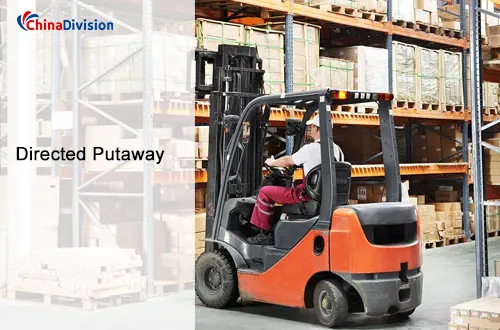How Does Directed Putaway Improve Warehouse Efficiency?
Warehouse management is crucial to success, and putaway is one of the most important aspects of warehouse operations, yet it's often overlooked. Directed putaway stands out as an advanced, technology-driven approach that can maximize efficiency, minimize errors, and improve overall warehouse productivity.
Table of Contents
- Have you ever been troubled by the following problems?
- What is directed putaway?
- Advantages of Directed Putaway
- What are the common putaway types?
- Directed Putaway Comparison with Other Putaway Strategies
- Why do B2B businesses and e-commerce sellers need targeted putaway?
- Core Decision Rules for Directed Putaway
- Frequently Asked Questions and Answers about Directed Putaway
- How does Chinadivision optimize warehouses through directed putaway?
Have you ever been troubled by the following problems?
Newly arrived goods get lost in the warehouse, causing pickers to spend countless hours searching for them?
Warehouse space is underutilized, with some areas filled and others empty?
High-value goods are mixed with regular items, increasing shrinkage and management risks?
During peak season, warehouse operations become chaotic, order processing is slow, and customer complaints arise.
If you answered yes to any of these questions, the core of the problem may lie in the first step of warehouse operations—putaway.
In this blog post, we'll explore what directed putaway is, how it differs from other approaches, and why it can be a game-changer for international companies seeking to streamline their supply chains.
What is directed putaway?

Directed putaway is an intelligent warehouse management strategy that uses real-time data and predefined rules to determine the optimal storage location for each incoming item. Unlike traditional methods where operators manually determine inventory placement, directed putaway automates the decision-making process, ensuring items are stored in the most efficient location based on factors such as:
Item size and weight
Demand frequency (fast-moving items vs. slow-moving items)
Storage capacity and availability
Proximity to picking areas
Special handling requirements (e.g., hazardous materials, temperature-sensitive goods)
Features of Directed Putaway:
System-driven, no human judgment required
Product sorting based on size, weight, temperature requirements, and more
Optimized warehouse space and picking routes
Improved inventory accuracy and operational efficiency
By leveraging a warehouse management system (WMS) and advanced algorithms, directed putaway can minimize shipping times, reduce congestion, and increase order fulfillment speed. An inefficient putaway strategy can, like a domino effect, lead to inefficiencies in subsequent inventory, picking, and shipping processes.
Advantages of Directed Putaway
Improve warehouse efficiency: Reduce manual judgment time and expedite the warehousing process.
Optimize space utilization: The system intelligently assigns locations based on product attributes, avoiding wasted space.
Reduce error rates: System guidance reduces human error.
Increase picking speed: A rational layout shortens picking paths.
Support multi-warehouse collaboration: Suitable for complex warehousing scenarios with multiple warehouses and multiple product categories.
What are the common putaway types?
Fixed-Location Putaway: Each product has a pre-assigned, fixed location. Suitable for warehouses with stable inventory and a small number of SKUs. This method is simple but extremely inflexible and has low space utilization.
Random Putaway: Products are placed in any available location. This flexibility, but lack of planning, can lead to the dispersion of similar products, significantly increasing subsequent picking paths and time.
Clearly, neither of these methods can meet the extreme speed, accuracy, and cost control requirements of modern international e-commerce logistics. Directed Putaway
Directed putaway is a core feature of modern warehouse management systems (WMS) that seamlessly addresses the shortcomings of traditional methods. Based on a set of pre-defined, scientifically-based business rules, the system intelligently directs operators to the optimal location for each item.
This eliminates guesswork and instead enables precise, data-driven decision-making. It is sometimes referred to as dynamic putaway or smart putaway because it responds to warehouse dynamics in real time.
Directed Putaway Comparison with Other Putaway Strategies
- Fixed Location Stocking
In this method, each SKU is assigned a permanent storage location. While simple to implement, it can lead to inefficiencies, such as poor space utilization or increased shipping times if high-demand items are stored far from the picking area.
Advantages of Directed Putaway: Dynamically assigning storage locations based on current demand and space availability optimizes space usage and reduces travel time.
- Dynamic Putaway
Dynamic putaway allows operators to select storage locations based on real-time availability, but without automated guidance, this can lead to inconsistent placement and reduced efficiency.
Targeted Putaway Advantage: Combining the flexibility of dynamic putaway with intelligent automation ensures consistent and optimal placement every time.
- Intelligent Putaway (AI-Driven Putaway)
Intelligent putaway leverages AI to predict demand patterns and optimize storage locations. While highly effective, it requires advanced AI capabilities and massive datasets for optimal performance.
Targeted Putaway Advantage: A more accessible alternative that uses rules-based logic and real-time data to achieve similar efficiency gains without the need for complex AI infrastructure.
Why do B2B businesses and e-commerce sellers need targeted putaway?
For international businesses handling large inventories and complex supply chains, manual or outdated putaway methods can lead to:
Increased labor costs due to inefficient warehousing
Higher error rates due to misplaced inventory
Slower order fulfillment due to distance from the picking area
Wasted warehouse space due to inefficient storage utilization
Directed Putaway addresses these challenges by:
Reducing operating costs by optimizing storage and labor efficiency
Increasing accuracy by minimizing human error in storage placement
Speeding up order fulfillment by placing high-demand items closer to the picking station
Maximizing warehouse capacity through more efficient space utilization
Core Decision Rules for Directed Putaway
Product Characteristics
The system automatically distinguishes items by weight, size, temperature requirements (e.g., ambient vs. refrigerated), hazardous materials, high-value items, and routes them to areas that meet these characteristics.
Turning Rate (ABC Analysis)
Best-selling items (Class A items) are automatically assigned to the most accessible locations closest to the picking area, while slow-moving items (Class C items) may be placed in high-bay racks or deep in the warehouse. This significantly reduces travel distance for picking.
Inventory Replenishment Strategy
For items that require batch picking, the system centrally stores them. For items that strictly adhere to a "first-in, first-out" (FIFO) or "last-in, first-out" (LIFO) order, the system plans routes.
Space Utilization
The system provides real-time visibility into the available space in each shelf location and prioritizes locations that maximize space utilization, avoiding wasted space.
An optimized warehouse putaway process should be: receiving goods → scanning → the WMS generates a directed putaway task → the operator receives instructions via an RFID terminal → delivers the goods to the designated shelf location → scanning the shelf location to confirm completion. The entire process is clear, accurate, and paperless.
Frequently Asked Questions and Answers about Directed Putaway
Is directed putaway suitable for small warehouses?
Of course! While large warehouses can benefit greatly from directed putaway, smaller warehouses can also improve efficiency by reducing manual decision-making and optimizing storage space.
What is the difference between Directed Putaway and Dynamic Putaway?
Dynamic Putaway allocates locations based on real-time inventory availability, making it more flexible but relying on manual judgment. Directed Putaway, on the other hand, is automatically allocated by the system based on preset rules and is more suitable for warehouses with high SKU counts and high-frequency operations.
How does Directed Putaway integrate with your existing WMS?
Most modern WMS solutions support Directed Putaway through configurable rules and algorithms. Chinadivision's WMS is fully optimized for Directed Putaway, ensuring seamless integration with your existing operations.
Is Directed Putaway suitable for cross-border e-commerce?
Absolutely. With the high number of SKUs and fragmented orders in cross-border e-commerce, Directed Putaway can significantly improve picking efficiency and inventory accuracy, reducing operating costs.
Can Directed Putaway handle seasonal inventory fluctuations?
Yes! Directed Putaway is highly adaptable and can adjust storage locations based on seasonal demand fluctuations, ensuring optimal placement year-round.
What if your inventory includes items with special handling requirements?
Directed Putaway excels at managing specialized inventory by incorporating rules for hazardous materials, temperature-sensitive goods, and other unique storage requirements.
How does Chinadivision optimize warehouses through directed putaway?
At Chinadivision, we specialize in providing customized international warehousing and logistics solutions for B2B businesses and e-commerce sellers. Our advanced directed putaway system ensures your inventory is stored in the most efficient location, reducing costs and increasing fulfillment speed.
Our advantages:
Our proprietary WMS supports various strategies, including Directed Putaway and Dynamic Putaway.
Supports barcode/RFID recognition for intelligent sorting and inventory tracking.
Multi-warehouse layout supports global order fulfillment.
Dedicated customer service and technical support helps you quickly implement smart warehousing.
Directed putaway is a disruptive technology in modern warehouse management, particularly for international logistics providers who handle complex inventory and diverse fulfillment requirements. Implementing directed putaway allows you to achieve faster putaway, improved space utilization, fewer errors, and more agile supply chain responsiveness.
If you're looking to reduce costs, improve accuracy, and accelerate order fulfillment, directed putaway is the solution you need. Chinadivision is committed to helping businesses like you optimize their supply chains through advanced warehousing and logistics services.





